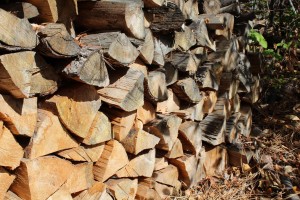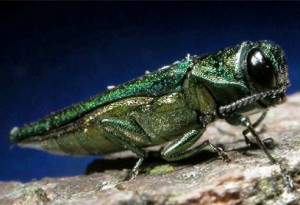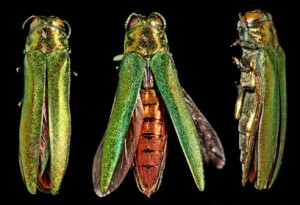Unintended Consequences of Transporting Firewood
by Marcia Anderson
Over the past 15 years, exotic insects like the Asian longhorned beetle, emerald ash borer (EAB), and hemlock woolly adelgid have killed millions of trees in cities and forests across the United States. Once established in new areas, these pests can quickly kill trees in our favorite forests, parks, communities, and campgrounds. The U.S. Department of Agriculture (USDA) estimates that over 30 million ash trees have already been killed by the emerald ash borer in Michigan alone, with millions dead or dying in other states (see related blog).
Firewood has been shown to be an especially troublesome means by which pests are spread. According to the USDA, the best preventative measure to protect our uninfested urban and rural forests from these pests is to limit the movement of infested materials, including firewood.
Firewood is frequently moved long distances by campers and retailers. Not surprisingly, pest infestations are showing up around campgrounds and highway rest areas. In many states, all trees used as firewood are now regulated since they have the potential to harbor invasive insects and diseases.
Firewood has historically been moved with little consideration of the pests it could be harboring. However, the issue is getting increasing attention. This year, USDA and several states put out urgent pleas to avoid transporting firewood.
To protect forests and trees that are threatened by a host of invasive insects and diseases, regulation has become necessary. While regulations vary by state, they generally include restrictions on importing firewood, the movement of firewood within the state, and the transportation of firewood into state, local and federal parks.
Thirty states have imposed various levels of quarantine as a result of the emerald ash borer. In the Northeast alone, most states have restrictions on the movement of wood products. Other states, including Minnesota, Wisconsin, Michigan, Illinois, Indiana, Kentucky, Ohio, and Maryland, have also imposed regulations on the movement and importation of firewood. Some regulations do not allow the transport of wood beyond a 50-mile radius of an EAB-restricted zone. A restricted zone is the quarantine of an infested area that prohibits the movement of logs and firewood outside of the zone. Check USDA’s quarantine map before you move firewood, even to another town. Because EAB does not travel far on its own, limiting human transportation of infested material will slow its spread.
It is recommended to use locally-sourced firewood, or firewood that has been confirmed as pest free. Firewood producers and dealers must provide documentation on the source of their firewood. Note that seasoned wood alone is not an adequate treatment method because some insects can survive in untreated firewood for many months. Only firewood that is heat treated, kiln-dried (160° F for at least 75 minutes), is allowed to be brought into parks with source documentation.
Be warned that RVs and other vehicles that have been parked for long periods of time can also harbor tree pests and their eggs. If not removed prior to a road trip, these vehicles can introduce pests into a previously uninfested area. So, take the time to check your vehicle, especially the wheel wells, and remove any insects you find. You can also wash down your camper between trips to help remove any hitchhiking pests.
What is at risk from transporting these pests? The trees in your backyard, along your streets, and in your neighborhood, along with the wildlife that depend on them. In addition, jobs in the timber and forestry industries and manufacturing sector (flooring, cabinets, pallets, and even baseball bats) are impacted. A direct consequence to taxpayers are the costs borne by cities and towns to remove the hazardous trees killed by these pests.
Preventing the spread of pests is one component of an Integrated Pest Management program. Doing your part will help sustain the health of our great forest resources and neighborhood trees.
About the Author: Marcia is with EPA’s Center of Expertise for School IPM in Dallas, Texas. She holds a PhD in Environmental Management from Montclair State University along with degrees in Biology, Environmental Design, Landscape Architecture, and Instruction and Curriculum. Marcia was formerly with the EPA Region 2 Pesticides Program and has been a professor of Earth and Environmental Studies, Geology, and Oceanography at several universities.





